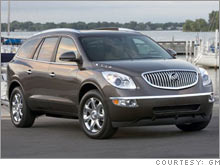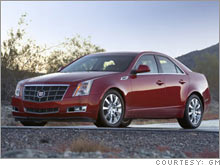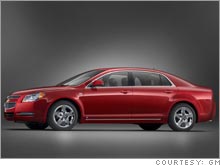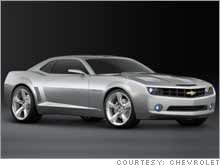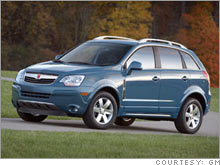What to drive in 2011'The market is so competitive, it is like a war,' GM's design boss Ed Welburn tells Fortune's Alex Taylor. Here's his battle plan for the next four years.NEW YORK (Fortune) -- Ed Welburn has seen the movie "Transfomers" twice. It is part of his job as vice president of global design at General Motors. A 2009 Chevrolet Camaro that he had a big hand in creating played a starring role in the movie as an Autobot named Bumblebee. Gazing into the future - and designing cars that we'll want to drive years from now - is how Welburn spends his days, some of which start at 6 a.m. He supervises the work of 1,500 people in 11 design studios around the world - including Russia, Brazil, China and Korea - and right now they are crammed with mockups of the cars customers will be seeing in 2010 and 2011.
"We're working flat out," Welburn said this week during a trip to New York. "Every detail has to be right. The market is so competitive, it is like a war." Meanwhile, the 2008 model year is shaping up as the most critical in General Motors (Charts, Fortune 500) history. Even as it tries to exit low-margin fleet sales, GM is seeing its share of the retail car market slip toward a dangerously low 20 percent. It badly needs attractive new models to convince buyers that they need to consider a Chevy or a Pontiac again. Otherwise, GM will continue to lose customers to Toyota (Charts), Honda (Charts) and Hyundai. Welburn has high hopes for a couple of '08s. The Buick Enclave, a crossover with three rows of seats that is just reaching dealers, is turning heads with its raised wheel arches and chrome portholes. Also on the way is the all-new Saturn Vue. Based on an Opel design and built with an all-steel body this time, it looks more clean and modern than its predecessor. Two new models most people haven't seen yet are the '08 Chevy Malibu, a slick international design that is generations beyond the clunky, slab-sided one currently on the market that has "rent me" written all over it. The Malibu arrives about the same time as the new Cadillac CTS, which is brighter, bolder and more attention-getting than its predecessor. And therein lies a story. Welburn and product guru Bob Lutz have been moving GM away from its slavish dependence on market research and focus groups to determine the direction of its car designs. Lutz famously compared the use of customer surveys to predicting the future by looking in a rear-view mirror. When Welburn was working on the original CTS for the 2003 model year, he got some bad news from the buyer clinics. The customers didn't like the car and it scored poorly. In Welburn's words, "The design scared them." But GM decided to stand behind Welburn and launched the CTS without significant changes. The car has gone on to rack up higher sales every year it has been on the market - the exact opposite of most models. That proves one of Welburn's axioms. "If a car design is appealing to you now [when you see it in a design studio], it may be a problem four years in [when it actually hits the market]" - not to mention four years later at the end of its life cycle. While Welburn scrambles to get GM cars back on customers shopping lists, he's been handed another problem. The government is on the cusp of boosting federal fuel economy standards dramatically - up to as much as 35 miles per gallon by 2020. For Welburn's team, that means paying a lot more attention to small cars. Welburn expects them to grow in popularity, so he's directed his designers to get more creative with them. They are paying particular attention to the size and weight of the vehicles, and to their aerodyamics. Making seemingly minor changes to grilles, hoods, mirrors and underbodies can produce a big difference in how the cars cut through the air. Besides, Welburn says, "I love working in the wind tunnel." Welburn supervises a global operation but thanks to technology, he doesn't run up a lot of frequent flier miles. The reason those meetings are scheduled at 6 a.m is so he can video conference in real time with his designers around the world. While that early morning start time is rough on him, it is harder on the studios in Australia and Korea that have to stay up far into the night. It is even tougher on the folks in Welburn's LA studio, who must show up at 3 a.m. to get face time with the boss. Who said the car business is glamorous? |
| ||||||||||||||

